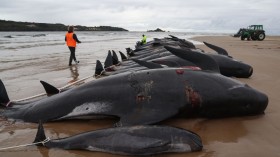Aerospace contracting leader Boeing Co. has unveiled the model design for its next-generation manned space capsule.
The Boeing Crew Space Transportation capsule, simply called the CST-100, was revealed Monday at the company's Kennedy Space Center operation facilities.
Like most traditional and conceptual manned space capsules, the CTS-100 had a "grumdrop" design, allowing it to easily deploy from the top of the rockets that will carry it into space.
According to the Orlando Sentinel, the craft still looks much like the manned capsules from the Apollo era. However, the interior of these swanky new transports could not be more different.
"Gone is the cold military cockpit feel, replaced by cool mood lighting and ergonomic seats," The Sentinel's Richard Burnett reports.
US Florida Senator Bill Nelson visited the Boeing facilities to take at look at the cockpit for himself.
"It's the first time I've seen it, and I have to say it looks a lot more comfortable that what we used to sit in," the senator told reporters.
Nelson served as payload specialist for the NASA shuttle program in 1986, which has since been discontinued (as of 2011) so that NASA could reallocate funds to projects dedicated to getting a man on Mars.
Since then, NASA has been paying Russia significant chunks of its budget to taxi US astronauts up to the International Space Station (ISS) in the Soyuz spacecraft. This arrangement has been threatened, however, with increasing tension between the US and Russia following the Russian occupation of Ukraine.
"I realize we're in a very tenuous position with our Russian relationship," former shuttle astronaut Chris Ferguson told reporters on Monday. "But I'm very confident we're gonna get [to the ISS] either way."
"Either way" refers to both the CST-100 and the DragonV2, two promising crafts recruited for human transport in a $1.1 billion NASA contract.
Boeing, Sierra Nevada Corporation and new front-runner SpaceX have all be rolling out new manned capsules designed to get astronauts to the ISS.
While impressively equipped with wireless systems and touch screens that take up less space - leaving room for up to seven astronauts - the Boeing design won't be available for actual use until 2017.
Also this week, NASA has unveiled its own "Orion" manned capsule - not designed for transport to the ISS, but rather deep space missions. The Orion will begin orbital testing in half a year's time.
© 2024 NatureWorldNews.com All rights reserved. Do not reproduce without permission.




